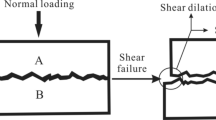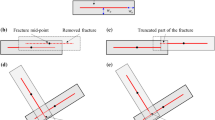Abstract
A deep geologic repository (DGR) situated on the Canadian Shield will be subject to long-term climate change that will markedly alter surface conditions as a result of glaciation and permafrost penetration. Systematic, two-dimensional and three-dimensional coupled thermal–hydraulic–mechanical finite-element simulations with varying degrees of coupling, including depth-dependent salinity (represented as a change in groundwater density) and temperature-dependent density and viscosity, were undertaken to address the implications of glaciation on groundwater flow system dynamics as it could affect DGR performance. The modelling domain consisted of a 1.6-km deep sub-regional scale (≈100 km2) fractured Shield flow system. Initial and transient thermal, hydraulic and mechanical boundary conditions were developed from two realizations of the University of Toronto Glacial Systems Model of the last Laurentide glaciation. Results indicate that during the glacial loading/unloading cycle, for this particular conceptual model, there is limited penetration of glacial meltwaters to depth and small residual anomalous hydraulic head. During glacial coverage, the mechanical factor of safety increases in the moderately fractured and sparsely fractured rock mass, but principal effective stress reorientation also occurs. Given the assumed nonglacial in situ state of stress and mechanical properties, the fracture zones were predicted to be less stable under glacial conditions.

















Similar content being viewed by others
Notes
Hereafter in this paper “equivalent freshwater head” is implied when the term “head” is used without qualification.
The meltwater penetration depth might have been overestimated because simplification of the FNM has led to higher predicted groundwater velocities in FZs.
References
Bear J (1972) Dynamics of fluids in porous media. Elsevier, New York, 764 pp
Biot MA (1941) General theory of three-dimensional consolidation. J Appl Phys 12:155–164
Boulton GS, Caban P, Hulton N (1999) Simulations of the Scandinavian ice sheet and its subsurface conditions. SKB R-99–73. Swedish Nuclear Fuel and Waste Management Company, Stockholm
Boulton GS, Chan T, Christiansson R, Ericsson LO, Hartikainen J, Jensen MR, Stanchell FW, Wallroth T (2004) Thermo-hydro-mechanical (T–H–M) impacts of Glaciation and implications for deep geologic disposal of nuclear waste. In: Stephansson O, Hudson JA, Jing L (eds) Coupled thermo-hydro-mechanical-chemical processes in geo-systems. Elsevier, Amsterdam, pp 299–304
Bouteca M, Gueguen Y (1999) Mechanical properties of rocks: pore pressure and scale effects. Oil & Gas Science and Technology—Rev.IFP 54:703–714
Chan T, Stanchell FW (2005) Subsurface hydro-mechanical (HM) impacts of glaciation: sensitivity to transient analysis, HM coupling, fracture zone connectivity and model dimensionality. Int J Rock Mech Min Sci 42:828–849
Chan T, Stanchell FW (2008) DECOVALEX THMC TASK E—implications of glaciation and coupled thermohydromechanical processes on Shield flow system evolution and performance assessment. Prepared by Atomic Energy of Canada Limited. Nuclear Waste Management Organization Technical Report NWMO TR-2008-03
Chan T, O’Connor PA, Stanchell FW (1998) Finite-element modelling of effects of past and future glaciation on the host rock of a used nuclear fuel waste vault. Prepared by Atomic Energy of Canada Limited. Ontario Hydro Nuclear Waste Management Division Report, 06819-REP-01200-0020 R00, Ontario Power Generation, Toronto
Chan T, Scheier NW, Guvanasen V (1999) MOTIF code Version 3.2 theory manual. Prepared by Atomic Energy of Canada Limited. Ontario Hydro Nuclear Waste Management Division Report 06819-REP-01200-0091-R00, Ontario Power Generation, Toronto
Chan T, Christiansson R, Boulton GS, Ericsson LO, Hartikainen J, Jensen MR, Mas Ivars D, Stanchell FW, Vistrand P, Wallroth T (2005) DECOVALEX III BMT3/BENCHPAR WP4: the thermo-hydro-mechanical responses to a glacial cycle and their potential implications for deep geological disposal of nuclear fuel waste in a fractured crystalline rock mass. Int J Rock Mech Min Sci 42:805–827
Chan T, Jensen MR, Stanchell FW, Vorauer A (2006) Numerical modelling of subsurface coupled THM processes in a sub-regional-scale groundwater flow system in a Canadian Shield setting during a glacial event: I. Conceptual model development. In: Xu W, Tan X, Yang S (eds) Proceedings GeoProc 2006: Advances on coupled thermo-hydro-mechanical-chemical processes in geosystems and engineering, pp 155–164, Nanjing, China, 22–25 May 2006
Combarnous MA, Bories SA (1975) Hydrothermal convection in saturated porous media. In: Chow VT (ed) Adv. Hydroscience, vol 10, pp 231–307. Academic, New York
de Marsily G (1986) Quantitative hydrogeology. Academic, New York
Gascoyne M, McMurry J, Ejeckam R (2004) Paleohydrogeological case study of the Whiteshell Research Area. Prepared by Atomic Energy of Canada Limited. Ontario Power Generation, Nuclear Waste Management Division Report 06819-REP-01200-10121-R00, Toronto
Guvanasen V, Chan T (2000) A three-dimensional numerical model for thermo-hydromechanical deformation with hysteresis in a fractured rock mass. Int J Rock Mech Min Sci 37:89–106
Hansson H, Shen B, Stephansson O, Jing L (1995) Rock mechanics modelling for the stability and safety of a nuclear waste repository. Executive summary. SKI Report 95:41
Hoek E, Brown ET (1988) The Hoek–Brown failure criterion—a 1988 update. In: Curran JC (ed) Rock engineering for underground excavations. Proceedings of 15th Canadian rock mechanics symposium, Toronto, pp 31–38
Horseman ST, Alexander J, Holmes DC (1991) Implications of long-term transient flow, coupled flow and borehole effects on hydrogeological testing in opalinus clay: preliminary study with scoping calculations. NAGRA report, NAGRA-NTB-91-16, Wettingen, Switzerland
Jaeger JC, Cook NGW (1976) Fundamentals of rock mechanics, 2nd edn. Halsted Press, New York
Kaiser PK, Maloney S (2005) Review of ground stress database for the Canadian Shield. Prepared by MIRARCO Mining Innovation. Ontario Power Generation, Nuclear Waste Management Division Report 06819-REP-01300-10107-R00
Nakka BW, Chan T (1994) A particle-tracking code (TRACK3D) for convective solute transport modelling in the geosphere: description and user’s manual, Atomic Energy of Canada Limited Report AECL-10881, COG-93-216, Chalk River, Canada
Neuzil CE (2003) Hydromechanical coupling in geologic processes. Hydrogeol J 11(1):41–83
Nguyen TS, Polischuk V, Selvadurai APS (1993) Effects of glaciation on a nuclear fuel waste repository. In: Proceedings of the 46th annual Canadian geotechnical conference, 1993 September, Saskatoon, Canada, pp 79–88
Ophori DU, Stevenson DR, Gascoyne M, Brown A, Davison CC, Chan T, Stanchell FW (1996) Revised model of regional groundwater flow of the Whiteshell Research Area. Atomic Energy of Canada Limited Report, AECL-11435, COG-95-443, Chalk River, Canada
Peltier WR (2003) Long-term climate change—glaciation. Ontario Power Generation, Nuclear Waste Management Division Report 06819-REP-01200-10113-R00, Toronto
Peltier WR (2004) Permafrost influences upon the subsurface. Ontario Power Generation, Nuclear Waste Management Division Report 06819-REP-01200-10134-R00, Toronto
Peltier WR (2006) Boundary condition data sets for spent fuel repository performance assessment. Ontario Power Generation, Nuclear Waste Management Division Report 06819-01200-10154-R00, Toronto
Spiessl SM, Mayer KU, MacQuarrie KTB (2006) Reactive transport modelling in fractured rock–redox stability study. Ontario Power Generation, Nuclear Waste Management Division Report No. 06819-REP-01200-10160-R00, Toronto
Srivastava RM (2002) The discrete fracture network model in the local scale flow system for the third case study. Ontario Power Generation, Nuclear Waste Management Division Report 06819-REP-01300-10061-R00, Toronto
Stevenson DR, Brown A, Davison CC, Gascoyne M, McGregor RG, Ophori DU, Scheier NW, F. Stanchell FW, Thorne GA, Tomsons DK (1996) A revised conceptual hydrogeologic model of a crystalline rock environment, Whiteshell Research Area, Southeastern Manitoba, Canada. Atomic Energy of Canada Limited Report, AECL-11331, COG-95-271, Chalk River, Canada
Sykes JF, Normani SD, Sudicky, EA (2003) Regional scale groundwater flow in a Canadian Shield setting. Ontario Power Generation, Nuclear Waste Management Division Report 06819-REP-01200-10114-R00, Toronto
Sykes JF, Normani SD, Sudicky, EA, McLaren RG (2004) Sub-regional scale groundwater flow within an irregular discretely fractured Canadian Shield setting. Ontario Power Generation, Nuclear Waste Management Division Report 06819-REP-01200-10133-R00, Toronto
Thorne GA, Gascoyne M (1993) Groundwater recharge and discharge characteristics in granitic terranes of the Canadian Shield. Presented at IAH 24th Congress on hydrogeology of hard rock, Oslo, Norway, June 28–July 2, 1993
Acknowledgments
This study was funded by the Nuclear Waste Management Organization (NWMO) as part of its technical research and development program. The authors thank Andre Vorauer, Mark Jensen and Ben Belfadhel of NWMO for project guidance, technical discussions and/or technical reviews, Prof. W. R. Peltier for providing detailed results of University of Toronto glaciation model, L. Cotesta and P. K. Kaiser of MIRARCO Mining Innovation for scientific visualization support and in situ stress recommendation, respectively, S. D. Normani for providing electronic files of the DEM, surface water hydrology and boundary coordinates, T. S. Nguyen of the Canadian Nuclear Safety Commission for valuable suggestions, an anonymous reviewer for careful perusal and editorial corrections of the manuscript and Bonnie St. Denis for expert word-processing. This paper does not necessarily reflect the views or positions of NWMO. The authors are solely responsible for all contents and views in this paper.
Author information
Authors and Affiliations
Corresponding author
Rights and permissions
About this article
Cite this article
Chan, T., Stanchell, F.W. Implications of subsurface thermal–hydraulic–mechanical processes associated with glaciation on Shield flow system evolution and performance assessment. Environ Geol 57, 1371–1389 (2009). https://doi.org/10.1007/s00254-008-1555-y
Received:
Accepted:
Published:
Issue Date:
DOI: https://doi.org/10.1007/s00254-008-1555-y




